Bottle gourd
Bottle gourd is widely cultivated in India and is available year-round. Its name derives from its elongated, bottle-like shape and historical use as a vessel. When young, the fruits are used in various dishes, sweets, and pickles. Once matured, their tough shells serve multiple purposes such as water containers, household utensils, and even fishing net floats. As a vegetable, it is known for its easy digestibility and cooling properties. It also acts as a diuretic and is believed to benefit heart health. The pulp of the fruit is used as an antidote for certain toxins and is effective against constipation, night blindness, and cough.
Bottle gourd is an annual vine that climbs and typically grows for about 3 ½ to 4 months. Its flowers are solitary, creamy white, and bloom during the night. The fruits are pulpy and come in various shapes and sizes.
Season-
Seeds of bottle gourd are typically sown between January and February for the summer crop, and between June and July for the rainy season crop.
States of Cultivation-
In India it is grown in states like, Bihar, Madhya Pradesh, Haryana, Uttar Pradesh, Chhattisgarh, Orissa, Assam, Andhra Pradesh, Punjab, etc.
Bottle gourd is a warm-season vegetable that thrives in temperatures warmer than those suitable for musk melons and watermelons. While it can withstand cooler conditions better than these crops, it is highly sensitive to frost. It requires a minimum temperature of 18oC in early growth stages but optimum temperature for its growth is about 24-27oC.
The optimal soil type for growing bottle gourd is well-drained and fertile silt loam. Its deep tap roots make it well-suited for cultivation in river beds, where it can establish strong vine growth. The Optimum soil pH is 6-6.7, but plants tolerate alkaline soils upto pH of 8.
Bottle gourd seeds are typically sown directly into well-prepared beds or containers.
Spacing-
Use row spacing of 2-2.5m and plant to plant distance of 40-50cm.
Depth-
Seeds should be sown at a depth of 1-2cm.
Seed Rate-
500-600gm seeds are enough to plant in one acre of land.
Seed Treatment-
Treat the seeds with Bavistin @0.2% @3gm/kg of seeds to protect the seeds from any kind of fungal disease.
Clear the land of weeds, stones, and other debris. Ensure no residue of previous crops that could affect bottle gourd growth. Plow the land deeply to break up soil clods and improve aeration. Follow with harrowing to level the field and create a fine tilth. Incorporate well rotten farm yard manure to improve soil fertility and structure.
Prepare raised beds or ridges and furrows to enhance drainage and prevent waterlogging.
Immediate irrigation should be given after sowing. Depending on soil type and climatic conditions, drip irrigation or furrow irrigation can be best method for cultivating bottle gourd.
During the summer season, bottle gourd cultivation typically requires irrigation about 6 to 7 times to ensure adequate moisture for optimal growth. In contrast, during the rainy season, irrigation is provided only when necessary.
For optimal growth, apply Farm Yard Manure (FYM) at a rate of 20-25 tonnes per acre. Additionally, provide a nitrogen fertilizer dose of 28 kg per acre, applied as urea at a rate of 60 kg per acre.
The nitrogen should be applied in two doses:
- The first dose of nitrogen, amounting to 14 kg per acre (equivalent to 30 kg of urea per acre), is applied at the time of sowing.
- The second dose of nitrogen, also 14 kg per acre (equivalent to 30 kg of urea per acre), is applied at the time of the first picking of bottle gourds.
To manage weed growth effectively during the initial stages of bottle gourd growth, it is recommended to perform 2-3 hoeings. These hoeing sessions help to keep the soil around the plants clear of weeds, promoting their healthy establishment.
Another effective method to manage weeds, especially during the rainy season, is earthing up. This involves mounding soil around the base of the plants, which helps to suppress weed growth and stabilize the plants during periods of heavy rain.
Mulching helps reduce weed growth by forming a protective layer between the soil and weeds. Organic mulches, including straw and grass clippings, prevent weed emergence and boost soil quality as they decompose.
If weed infestation is more then we can use certain weedicides such as Fluchoralin @800ml/acre.
- Nitrogen-
Symptoms-
The bottle gourd plants exhibit stunted vegetative growth and limited fruit production. They appear pale and slender, with new leaves being small yet retaining their green color. However, the oldest leaves turn yellow and eventually die off. This yellowing progresses upwards along the shoots to affect younger leaves as well.
Management-
Foliar spray of Urea @2% at fortnightly.
- Potassium-
Symptoms-
Potassium deficiency manifests in bottle gourd plants with yellowing and browning of older leaves. Initially, symptoms appear at the leaf margins and spread inward between the veins. Areas around the major veins remain green until the deficiency worsens. As the condition progresses, affected areas develop a brown scorched appearance, eventually causing the leaf to become dry and papery.
Management-
Foliar application of KCl @1% at weekly interval.
- Calcium-
Symptoms-
Newly emerging leaves show signs of scorching and distortion. These leaves may appear curled or cupped downwards because their margins fail to expand fully. However, mature and older leaves typically remain unaffected by these symptoms.
Management-
For soils lacking calcium, gypsum should be applied based on soil test findings to meet exact needs. Alternatively, calcium sulfate (CaSO₄) can be administered via foliar spray as a 2% solution in water.
- Magnesium-
Symptoms-
A deficiency in magnesium results in the yellowing of older leaves in plants. This symptom typically starts between the prominent veins of the leaves, leaving a thin green border along the edges. As the deficiency progresses, the yellow areas develop a light tan burn.
Management-
To address magnesium deficiency in soils before planting, incorporate either magnetite at a rate of 300 kg per acre or dolomite at a rate of 800 kg per acre. For ongoing magnesium supplementation during the growing season, apply fortnightly foliar sprays of magnesium sulfate (MgSO₄) at a concentration of 2 kg per 100 liters of water.
- Boron-
Symptoms-
Older leaves exhibit a distinct broad yellow border along their margins. Young fruits are susceptible to premature death or abortion. The plant’s growth is stunted, and the leaves develop yellow streaks that later transform into rough, corky patches known as scurfing on the fruit’s skin.
Management-
Foliar spray of 0.2% Borax at forthrightly interval.
- Iron-
Symptoms-
Iron deficiency in plants results in the newest leaves exhibiting a uniform pale green chlorosis, while older leaves retain their dark green coloration. Initially, the veins of the affected leaves remain green, creating a net-like pattern. As the deficiency worsens, even the minor veins lose their green color, and the leaves may eventually develop a burnt appearance, particularly when exposed to intense sunlight.
Management-
Foliar application of FeSO4 @0.5%
- Manganese-
Symptoms-
Manganese deficiency in plants causes the veins of middle to upper leaves to remain green, contrasting with the mottled appearance of the leaf blade, which ranges from pale green to yellow.
Management-
Spray the foliage with MnSO4 @100g/100L of water.
Physiological disorders are non-infectious conditions that arise from environmental factors rather than pathogens.
- Air Pollution-
Symptoms-
- Leaf discoloration
- Necrotic Patches
- Leaf Burn
- Stunted growth
- Abnormal flowering and fruit development
Curative Measures-
- Foliar spray of Calcium nitrate or Magnesium Sulfate. These can help overcome nutrient deficiency in plants.
- Use antioxidant solutions like ascorbic acid (vitamin C) or seaweed extracts. These can help mitigate oxidative stress caused by pollutants and enhance plant resilience.
- Apply gypsum to the soil to improve soil structure and mitigate the effects of pollutants like sulfur dioxide.
- Apply organic mulch around the base of plants to conserve soil moisture and reduce stress on the plants caused by pollutants.
- Rotate crops to minimize continuous exposure of bottle gourd plants to pollutants in the soil and air.
- Ozone Layer-
Symptoms-
- Leaf Damage
- Reduced crop growth
- Genetic Changes
- Increased susceptibility to pest and disease
Curative Measures-
- Use shade nets or structures to reduce direct exposure of plants to UV radiation.
- Apply organic mulch to conserve soil moisture and protect roots from heat stress.
- Maintain balanced nutrition to support plant health and resilience.
- Ensure adequate water supply to help plants cope with stress caused by UV radiation.
- Chilling Injury-
Chilling injury in bottle gourd occurs when the plants are exposed to low temperatures, typically below their optimal range. This condition can lead to several symptoms and adverse effects on the plants:
- Yellowing and water soaked appearance.
- Discoloration of fruits
- Fruits may become soft, mushy and prone to decay.
- Leads to reduced growth and development
- Abnormal ripening
Curative Measures-
- Prune affected plant areas.
- Ensure plants receive adequate water to alleviate stress. However, avoid overwatering, as waterlogged soils can exacerbate root damage.
- Apply balanced fertilizer
- Apply mulch around plants to help regulate soil temperature and moisture levels, which can aid in reducing stress on recovering plants.
- Red Pumpkin Beetle-
Stage of attack- Early Seedling Stage
Symptoms-
- The adult beetles and larvae feed voraciously on the leaves of bottle gourd plants. They create irregular holes and skeletonize the leaves, leaving behind a lace-like appearance.
- Heavy infestations of red pumpkin beetles can lead to severe defoliation of bottle gourd plants.
- In addition to leaves, the beetles may also feed on tender stems, causing damage and weakening the plant’s structure.
- Red pumpkin beetles may also damage young fruits. They create shallow pits or scars on the surface, which can lead to secondary infections or affect fruit quality.
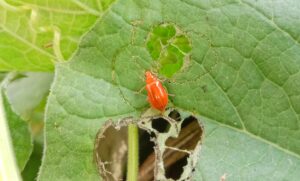
Management-
- Ploughing fields immediately after harvest disrupts the hibernation of adult red pumpkin beetles, aiding in their elimination.
- Removing adult beetles manually helps reduce their numbers and minimize damage to bottle gourd plants.
- Application of insecticides like malathion 50 EC @7ml/L of water, dimethoate 30 EC @2.5ml/L of water, or methyl demeton 25 EC @2ml/L of water.
- Fruit Flies-
Stage of attack- Early Seedling Stage
Symptoms-
- Secretion of a resinous fluid from affected fruits.
- Deformation and irregular shape of bottle gourd fruits.
- Infected fruits are prone to premature dropping from the vines, rendering them unsuitable for consumption.
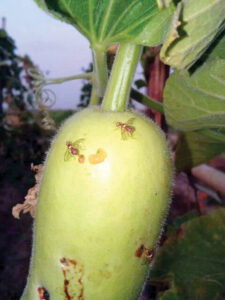
Management-
- Collect and remove all the infected plants from the field and maintain field sanitation.
- After harvest, it is beneficial to plough and overturn the soil to expose pupae to sunlight and air.
- Apply Carbaryl 50 %WP @3gm/L of water & Malathion 30EC @1ml/L of water.
- Stem Borer-
Stage of attack- Vegetative & Early Fruiting stage
Symptoms-
The larvae of stem borers tunnel into the stems, where they feed on the inner tissues, causing damage that can weaken the plant and reduce yield. It can weaken the plant, affect its growth, and sometimes lead to wilting or even death of the plant if the infestation is severe.
Management-
- Collect and destroy the affected plants from the field and maintain field sanitation.
- Avoid planting bottle gourd in the same location year after year to reduce pest buildup.
- Encourage natural enemies such as parasitic wasps that prey on stem borer larvae. Planting nectar-rich flowers can attract beneficial insects.
- Planting trap crops that attract stem borers away from the main crop can reduce damage to bottle gourd plants.
- Application of Malathion 50EC @200-300ml/acre.
- Stem Gall Fly-
Stage of attack- Early stages of growth
Symptoms-
- Swelling or galls form on the stems and sometimes on the leaves where the larvae feed.
- Infested plants show stunted growth.
- Leaves may turn yellow and wilt due to the damage caused by the larvae feeding inside the plant tissue.
- In severe infestations, stems may crack or split open at the sites of gall formation.
Management-
- Spray any of the following insecticides-
Malathion 50EC @250-300ml/acre
Dimethoate 30EC @1.5ml/L of water
- Pumpkin Caterpillar-
Stage of attack- Vegetative and Reproductive Stage
Symptoms-
- During its early stages, the young larva scrapes away the chlorophyll content from the leaves, leaving behind thin, translucent patches.
- The caterpillar folds and webs the leaves, creating sheltered feeding areas where it continues to consume leaf tissue.
- It also consumes flowers, potentially reducing the plant’s ability to produce fruits.
Management-
- Use plant derivatives such as neem.
- Collect and destroy the affected plant from the field and maintain field sanitation.
- Spray any of the following insecticides-
Malathion 50EC @250-300ml/acre
Dimethoate 30EC @1.5ml/L of water
- Bottle gourd Plum Moth-
Stage of attack- Early Seedling Stage
Symptoms-
- Primary symptom is the visible damage to fruits. The larvae of the moth bore into the fruits, creating holes or tunnels. This can lead to fruit deformation, reduced quality, and increased susceptibility to rotting.
- External signs of infestation include holes or puncture marks on the surface of fruits, where larvae have entered.
Management-
- Collect and destroy the affected plants from the field.
- Spray any of the following insecticides-
Malathion 50EC @250-300ml/acre
Dimethoate 30EC @1.5ml/L of water
- Leaf Miner-
Stage of attack- Vegetative and early reproductive stage
Symptoms-
- The most noticeable symptom is the presence of serpentine or winding mines on the leaves. The mines appear as whitish or translucent trails that can vary in shape and size depending on the species of leaf miner.
- As the larvae feed inside the leaves, they disrupt the normal structure and function of leaf tissues. This can lead to visible damage such as discolored patches, necrotic areas, or even holes in severe cases. The affected leaves may appear distorted or curled due to the feeding activity of the larvae.
- Result in reduced plant vigor, slowed growth, and overall decreased yield potential.
- Infested plants may show signs of stress, such as yellowing or wilting of leaves, particularly if the infestation is severe or prolonged.
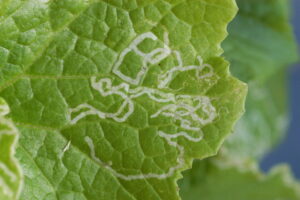
Management-
- Set up yellow sticky trap to attract leaf miners.
- Spray Cypermethrin 4% SC @400ml/acre
- Powdery Mildew-
Causal Organism- Erysiphe spp
Symptoms-
- White powdery spots can form on both the surfaces of and expand into large blotches.
- Fruits ripen prematurely
- Infected plants produce fewer and small fruits
- Pale yellow leaf spot can be seen
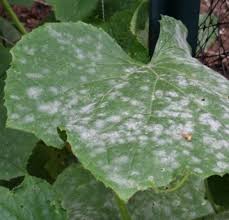
Favorable Conditions-
Warm, humid conditions and temperature between 20-28oC favors the growth of this fungus.
Management-
- Plant disease resistant varieties.
- Apply wettable sulphur @0.2%
- Collect and destroy the infected plants from the field and maintain field sanitation.
- Apply any of these following fungicides-
Tebuconazole @250ml/acre
Tetraconazole 3.8% @2ml/L of water
Propiconazole 25%SC @2ml/acre
Copper Sulphate @2gm/L of water
- Leaf Spot-
Causal Organism- Xanthomonas cucurbitae
Symptoms-
- Leaves develop small angular, brown or colored straw spots with yellow halo. Leaf spots dry out and drops off, leaving irregularly shaped holes in the leaves.
- Spots are typically confined within the leaves.
- Water soaked tan, small circular spots on fruits.
- Bacterial soft rot often develops after fruit spots and rot the entire fruit.
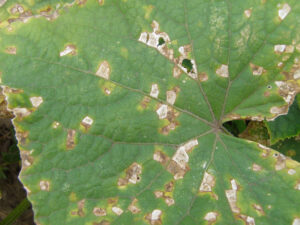
Favorable Conditions-
High Relative humidity of 90-95%, Moist conditions, dense plantings and warm temperature of 20-30oC favors the growth of this disease.
Management-
- Plant disease resistant varieties.
- Use drip irrigation instead of overhead irrigation
- Remove and destroy all the infected plants from the field
- Apply Mancozeb 75%WP @2gm/L of water
- Downy Mildew-
Causal Organism- Peronospora parasitica
Symptoms-
- Yellow to pale green spots form on the upper surface and lower surface of the leaves, there is a velvety fuzz.
- Later these spots turn to brown in color.
- Entire leaves dries up quickly.
- As the disease progress, spots turn to necrotic.
- Diseases plants get stunted and die.
- Fruits produce may not mature and have a poor taste.

Favorable Conditions-
Mild temperature and wet weather favors the growth of this fungus.
Management-
- Plant disease resistant varieties.
- Apply Mancozeb @2gm/L of water
- Gummy Stem Blight-
Causal Organism- Didymella bryoniae
Symptoms-
- Brown-black, water soaked lesions appear on stems which later become dry and wilt.
- Irregular tan to brown blotches appears on leaves which may lead to wilting and blight of the foliage.
- The development of gummy, reddish brown substance on the surface of lesions.
- Premature defoliation of the plants.
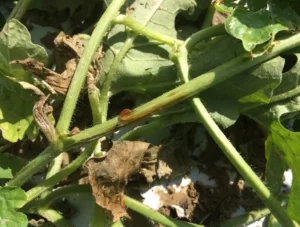
Favorable Conditions-
Moist weather, relative humidity of above 80%, temperature of about 25-32oC favors the growth of this disease.
Management-
- Application of Azoxytrobin 23%SC @1gm/L of water
- Apply Metalaxyl 8%+Mancozeb 64%WP @1.5-2.5gm/L of water
- Treat the seeds with Metalaxyl 35%WS @6-7gm/kg of seeds.
- Fusarium Wilt-
Causal Organism- Fusarium oxysporum
Symptoms-
- The first symptom is the clearing of veinlets and chlorosis of the leaves.
- The younger leaves may die in succession and the entire leaves may wilt and die in a course of few days.
- In severe infestation, petilole and leaves may wilt and drop off from the plant.
- At the later stages, browning of vascular system occurs.
Favorable Conditions-
Temperature between 25-27oC, warm moist soil favors the growth of this disease.
Management-
- Rotate crops with non-host crops such as cereals, and legumes to reduce soil inoculum levels.
- Collect and destroy the infected plants from the field and maintain field sanitation.
- Avoid water logging, as excessive soil moisture an promote fungal growth. Use drip irrigation to minimize leaf wetness and soil compaction.
- Use bio control agents such as Trichoderma viride and Pseudomonas fluorescens.
- Apply Carbendazim @300gm/acre.
- Cucumber Mosaic-
Causal Organism- Cucumber Green Mottle Mosaic Virus
Symptoms-
- Symptoms such as Curling, mottling, distorted leaves, stunted growth can be seen on the bottle gourd plants.
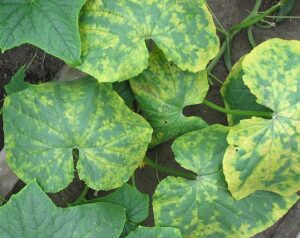
Favorable Conditions-
Relative humidity of 90%, High soil moisture, frequent rains favors the growth of this virus.
Management-
- Destroy the affected plants from the plants.
- Keep the field weed free
- Remove alternate host from the field
- Avoid overcrowding
- Practice crop rotation to reduce the transmission of this disease.
- Use insecticide to control aphids, as aphids are the vector of this disease, insecticide such as Imidacloprid @0.5ml/L of water.
Harvesting-
Bottle gourd can typically be harvested between 55 to 75 days after planting. It is essential to pick the fruit while the rind is still tender and green. If harvesting is delayed, the fruit may become unsuitable for sale.
Yield-
Yield depends on different factors such as variety used, climatic conditions, soil fertility etc but the average yield of bottlegourd is about 150-160 quintal/acre.